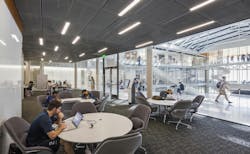Take a moment to contemplate the seismic shift in the volume and accessibility of knowledge over the last few decades. Futurist Buckminster Fuller posited that human knowledge had doubled every century until 1900; by 1982 it had accelerated to every 12 months. Today, it is estimated to be every 12 hours. Not only does knowledge double every half-day, but our access to that knowledge is more fluid, seamless, and continuous.
Through our personal devices, each of us is a node in a vast information network. Why, then, do libraries even exist anymore, much less hold such sway in our collective imagination?
Libraries have been at the center of our civic lives for 2,000 years, but we need them for remarkably different purposes than we did 50 years ago. This relatively recent and tumultuous shift has raised questions about the functionality of the vast stock of existing academic libraries and what adjustments we can make to bring them into sync with such rapid advancements in knowledge.
Today, the fundamental role of the academic library is not to provide access to information, but to help researchers separate the signal from the noise. It is where we can go to filter out untrustworthy sources, evaluate large data sets, and make sense of an increasingly complex world. Replacing collections with makerspaces and lounges doesn’t intrinsically perform this function. We must propose changes to libraries that will enable them to shift from being guardians of knowledge to synthesizers of it.
By adapting spaces for existing libraries, such as Harvard’s Widener Library, architects have identified three adjustments that education institutions can make to help secure the role of the academic library as we move deeper into the information age.
First, rather than eliminate collections, curate them. We must make collections more potent by moving lesser-used or more widely available material off-site in favor of items that are less common or more physically meaningful. It is admittedly a challenge to get scholars to agree on how to prioritize collections, but focusing on quality over quantity will free up space for other activities without entirely removing the physical objects that remain important tools of thought. Collections areas can be reconfigured to be more visible and accessible, especially if their density is reduced.
Second, blend the physical and digital. The creation of “phygital” spaces will allow for the integrated study of digital and physical objects. A superpower of academic libraries is their ability to support cutting-edge scholarship by merging advanced digital tools with collections that often span centuries. Most spaces are designed for one (secure reading rooms) or the other (video conference rooms); merging these features will enable new forms of learning.
Third, improve cross-disciplinary access to advanced digital research methods. We must elevate the presence and availability of key research librarians by providing environments that merge staff workspace with collaborative phygital space. Co-locating research specialists across different practice areas (visualization, data management, search, etc.) and situating them in highly visible and accessible locations will emphasize synthesizing information over simply collecting it. The next-generation help desk is not a desk at all, but a prominently placed hive of staff and patron teamwork.
Creating advanced digital research environments will encourage the erosion of silos, as these spaces will especially support interdisciplinary projects that integrate knowledge across academic disciplines. Collaboration, long a buzzword, is an important dimension of interdisciplinary inquiry, and can be fostered through an ecosystem of workrooms, breakout space, and focus rooms that also offer immediate access to curated collections.
If such spaces could be secured by groups for greater lengths of time, they will become vital new destinations for interdisciplinary research teams seeking resource-rich home bases for working together on projects beyond individual departments.
As schools and universities consider these upgrades, we must address the elephant in the room: artificial intelligence. Will A.I. change everything all over again? If we reconfigure our libraries to address today’s challenges, will we just have to rinse and repeat in a decade? Maybe. But, A.I. is just as likely to increase our reliance on libraries. It will enhance our ability to evaluate vast collections of material and curate them in new and productive ways. It will deepen the interrelationship between the physical and digital by introducing a new range of tools for analyzing texts and artifacts. It will demand new forms of research expertise, ideally situated in the hands of librarians who are ready, willing, and able to press these tools into service.
If we acknowledge that libraries are here to help humans make sense of the world as it rapidly evolves around us, and if we adapt them accordingly, they will become more essential, not less, in the years to come.
Alex O’Briant, AIA, is a Principal at Ennead Architects, an architecture firm based in New York known for its innovative cultural, educational, scientific, commercial, and civic building designs.
About the Author
Alex O'Briant
Alex O’Briant, AIA, is a Principal at Ennead Architects, an architecture firm based in New York known for its innovative cultural, educational, scientific, commercial, and civic building designs.
Sign up for our eNewsletters
Get the latest news and updates


